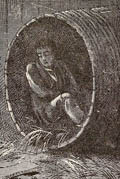|
[From] Chapter IX. Hunting. . . . Lewis and Clarke, in descending the Missouri in July, 1806, estimated that at one place they beheld twenty thousand buffaloes at a single view. At another place they saw such a multitude of the animals crossing the river that the stream for a mile was so filled up they could not proceed until the herd had passed. The buffaloes formerly ranged free and uninterrupted over the Great Plains of the West, only guided in their courses by that faithful instinct which invariably led them to the freshest and greenest pastures. Their only enemy then was the Indian, who supplied himself with food and clothing from the herds around the door of his lodge, but would have looked upon it as sacriledge to destroy more than barely sufficient to supply the wants of his family. Thus the monarch of the Plains was allowed free range from one extremity of the continent to the other. With the advent of the European an enemy appeared, who made war upon them and the insatiate slaughter inflicted upon them by this avaricious stranger in a few years produced a very sensible dimunition in their numbers, and greatly contracted the limits of their wanderings. This enemy, in his steady advance, also caused the original proprietor of the soil to recede before him, and to diminish in numbers almost as rapidly as the buffalo. Thousands of these animals were annually slaughtered for their skins, and often for their tongues alone; animals whose flesh is sufficient to afford sustenance to a large number of men are sacrificed to furnish a bon bouche for the rich epicure. This wholesale slaughter on the part of the white man, with the number consumed by the Indians, who are constantly on their trail, migrating with them as regularly as the season comes round, with the ravenous wolves that are always at hand to destroy one of them if wounded, gives the poor beast but little rest or prospect of permanent existence. It is only fourteen years since the western borders of Texas abounded with buffaloes; but now they seldom go south of the Red River, and their range upon the east and west has also very much contracted within the same time, so that they are at present confined to a narrow belt of country between the outer settlements and the Rocky Mountains. With this rapid dimunition in their numbers, they must, in the course of a very few years, become exterminated. In a very interesting paper upon this matter, written by the Hon. H. H. Sibley, of Minnesota, who is himself an excellent sportsman, and perfectly well acquainted upon the subject with which he treats, I find the following: "The multitudes of these animals (buffaloes) which have hitherto darkened the surface of the great prairies on the west of the 'Father of Waters' are fast wasting away under the fierce assaults made upon them by the white man as well as the savage. From data which, although not mathematically correct, are sufficiently so to enable us to arrive at conclusions approximating the truth, it has been estimated that for each buffalo robe transported from the Indian country at least five animals are destroyed. If it be borne in mind that very few robes are manufactured of the hides of buffalo, except of such as in hunter's parlance are killed when they are in season--that is, during the months of November, December, and January, and that even of these a large proportion are not used for that purpose, and also that the skins of cows are principally converted into robes, those of the males being too thick and heavy to be easily reduced by the ordinary process of scraping, together with the fact that many thousands are annually destroyed through sheer wantonness by civilized as well as savage men, it will be found that the foregoing estimate is a moderate one. From the Missouri region the number of robes received varies from 40,000 to 100,000 per annum, so that from a quarter to a half a million of buffalo are destroyed in the period of each twelve months. So enormous a drain must soon result in the extermination of the whole race; and it may be asserted with certainty that in twenty years from this time, the buffalo, if existing at all, will be only found in the wildest recesses of the Rocky Mountains. The savage bands of the West, whose progenitors have from time immemorial depended mainly upon the buffalo, must, with them, disappear from the earth, unless they resort to other means of subsistence, under the fostering care of the general government." |
